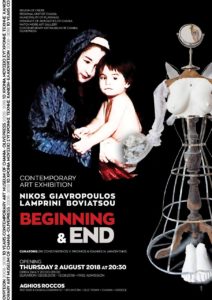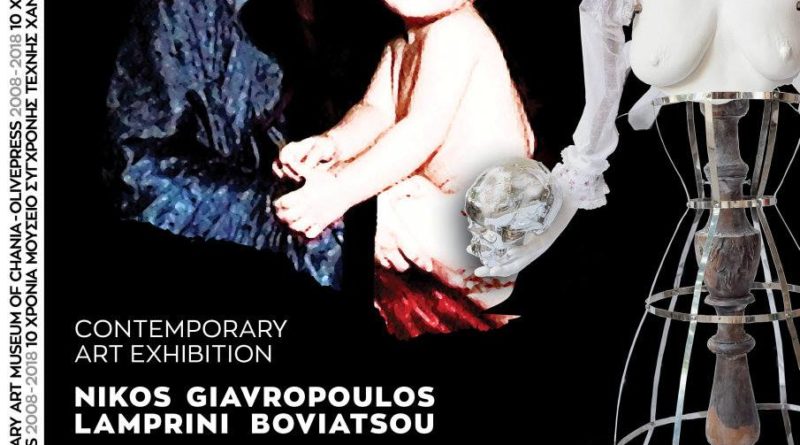Contemporary Art Exhibition “Beginning and End” – Chania 2nd -12th August
The two artists Lambrini Boviatsou (Chania) and Nikos Giavropoulos choose to present their works in a church rather than in the white cube spaces of a gallery, approaching the subject of Beginning and End with all its concomitant themes, birth, youth and old age, life and death – reflection of the great events demarcating human existence. Their exhibition spans the art media and involves video, photography, design, installation, painting, sculpture and mixed media, readymades and the like, in an attempt that defies stylistic coherence in favor of seizing best the matter of concern.
choose to present their works in a church rather than in the white cube spaces of a gallery, approaching the subject of Beginning and End with all its concomitant themes, birth, youth and old age, life and death – reflection of the great events demarcating human existence. Their exhibition spans the art media and involves video, photography, design, installation, painting, sculpture and mixed media, readymades and the like, in an attempt that defies stylistic coherence in favor of seizing best the matter of concern.
WHEN: 2nd – 12th August, 20.00 – 23.00
Exhibition opening :2 nd August 20.30
WHERE: Saint Rocco, Square 1821 / Daskalogianni Rd., Splantzia, Chania
Entrance: free
This exhibition is part of the anniversary “2008-2018: 10 years Museum of Contemporary Art Chania and Olivemill Art Factory in Dromonero”
The exhibition is co-organized by the Region of Crete, the Regional Section of Chania, the Municipality of Platanias and the Match More Art Gallery, will be open every day from 20:00 to 23:00 until 12.08.2018 , with Free Entrance.
“Lambrini Boviatsou is a painter who attaches several readymades on her drawings, i. e. real objects that complement the message of her images. The third dimension occupies the artist not solely in her drawings but also in sculptural form when she presents as part of her installation a puppet or mannequin that holds a skull, has wings and bears a mirror instead of a head in which part of the artist’s face is revealed. The installation is then completed by another four drawings: one of a young girl, most probably less than ten years old, posing frontally, with a real pen attached round her neck and the miniature of a family home on the level of her waist. The other is a drawing of an old woman, same pose, having in front of her waist an altarpiece with a real censer, placed in front of its main opening. The third is a chicken telephone puppet reminding the famous 1936 surrealist lobster telephone by Salvador Dali. Finally, the fourth is a drawing of the mannequin she exhibits in sculptural form. The sizes of the readymade objects Boviatsou employs are incompatible with her compositions and this fact along with her puppets and mannequins that might be taken as automata or angels, betray her imports from surrealism and metaphysical painting particularly as the latter was practiced by Giorgio de Chico.(…)
Nikos Giavropoulos exhibits two videos, one entitled Madonna, 1999, 4 minutes and 30 seconds and the other entitled Pieta, 2003, 7 minutes and 30 seconds which are placed one against the other. He also displays eight video stills from his videos, two in large format and six in smaller format which he has framed, superimposing at a distance of approximately 5 cm in front of them a black and white print of the colored image, thus simulating drawing that always precedes painting when making an artistic composition.
Giavropoulos departs from two famous masterpieces, on the one hand, the Madonna del Granducca by Raphael, 1505, which he restages in video, employing as models a young woman and her one year old son and, on the other, Pieta the famous sculptural complex by Michelangelo, 1498-1499. Giavropoulos makes a clear point about life and death, contrasting the restless boy in his young mother’s arms with the lifeless body of a young man on his mourning mother’s lap. Despite the clarity of the point, the artist selects to showcase a number of videos stills presenting culminating moments from both incidents, in exactly the same way as a traditional painter or photographer would have selected the best and most typical moments of an incident to portray.
Saint Rocco is one of the main Venetian religious monuments of Chania, Crete, built by the Paolini family, during the last phase of the Venetian rule, in 1630, fifteen years before the town was conquered by the Ottomans. Saint Rocco was reportedly born in 1295 in Montepelier, France, from a noble family and died very young at the age of thirty two after having devoted himself to priesthood. He was the saint that protected from plague and was greatly revered by the Venetians who devoted to him this elegant manierist church, according to the Latin inscription underneath the pediment. The church is naturally the place where humans celebrate the events of the beginning, birth and the end, death. Of course this is no longer a functioning church and this fact sparked the architectural interest of the artists to install their work and test whether art can replace religion when it comes to reflecting on some of the most important events of human life.(…)”.
(Dr Constantinos V. Proimos, lecturer at the Hellenic Open University and independent art critic)
www.zarpanews.gr


